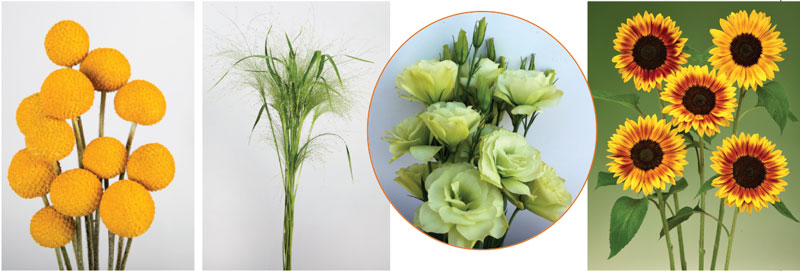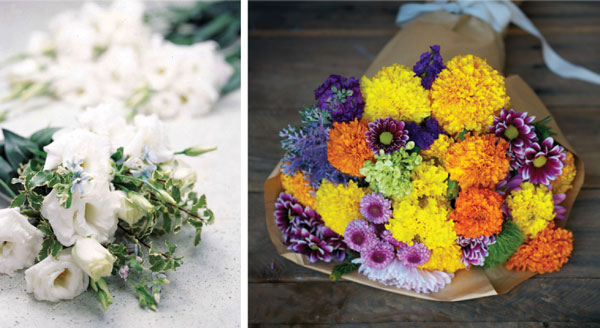10/1/2020
Specialty Cuts That Make the Cut
Scott Rusch
I can think of no better time in recent history to purchase cut flowers for no particular reason at all. 2020 hasn’t been an easy one; however, a trend we’re seeing is an increase in consumption over the summer months to brighten the home office, videoconference background or dinner table. Flowers have always been known to bring smiles, celebrate milestones and remember our loved ones, but it’s encouraging to hear many cut flower growers throughout North America reporting increased purchases in the summer months this year to help balance some of the earlier challenges due to the COVID-19 pandemic.
We’ve also seen an increase in the number of growers serving the North American consumer. The Association of Specialty Cut Flower Growers (ASCFG) reports membership doubling in the last five years. While local production is increasing, more sustainably produced, garden-look flowers are trending and being produced at large and small growers alike all over the world to meet the needs of todays’ consumers.
Most everyone will soon be preparing for Halloween at the end of October—it’s one of the most important retail consumer holidays in the U.S. Trending right along with it is Día de los Muertos, which follows a couple days after.
If you aren’t growing flowers for Día de los Muertos, you should consider it; it’s become an important consumer holiday and actively features flowers, especially marigolds. Marigolds are often used in the ofrenda (altar) and it’s believed they help attract souls to the altar with bright colors and strong fragrance.
As you evaluate your summer and fall programs this year, I’d like to share some of the newer introductions and underutilized varieties to consider for next year. Summer and fall are great for celosia, lisianthus, ornamental grasses, sunflowers, zinnias and a host of other crops. (For more on the varieties or growing tips, visit the breeding company’s website for more detailed information.)
And don’t forget—plan your marigolds for Día de los Muertos next year. Mark your calendars for October 31 to November 2, 2021.

Marigold Xochi Orange (Tagetes erecta)
BloomStudios Cut Flowers
Propagation form: Coated seed
The feature flower for Día de los Muertos is the marigold. There are many bedding plant types available, but recently, more breeding companies have been looking at marigolds for use as cut flowers, too. Xochi was bred and selected for stronger stems and richer colors during summer and fall cut flower production. The strong stems give growers a more durable, shippable stem.
You might be wondering about the name? Xochi is pronounced “So-Chee” and means “flower” or “princess of flowers.” It’s a shortened version of Xochitl, an ancient Mayan word used most commonly in Mexico.
The best stem length is achieved under long-day production. You can disbud for one large flower per stem or let it grow naturally and get a nice multibranched spray. It’s new for 2021 with coated seed available starting October 2020; a great new option for your summer programs and Día de los Muertos bouquets and grower bunches.
Celosia Sunday Cherry (Celosia plumosa)
BloomStudios Cut Flowers
Propagation form: Pelleted seed
Sunday Celosia was developed through a breeding partnership with Celex. In the most recent round of introductions, we were able to select several improved colors, including the variety Sunday Cherry because it really stood out in trials.
Sunday Cherry features a bright cherry red-rose color, which really stands out when you need a rich color in your bouquet. The series was the first professional cut flower series of the popular plume-shaped celosia that you normally see in ground planting and in bedding plant programs. Full plumes and long, strong stems enhance high-end retail mixed bouquets. It’s very heat tolerant, so it’s ideal for summer and fall programs. The bright color selections in the rest of the series give you a lot of options for that time of year when you’re looking for boldness.
Short, programmable production time and high yield make this ideal for high-density programs; we recommend planting 65 to 86 plants/m2 (6 to 8 plants/ft.2). A key tip for post-harvest is to keep this out of cold storage—best to hold before shipment in distilled water with many of your tropical cut flowers that prefer warmer storage.
Callistephus Fujimi (Callistephus chinensis)
American Takii
Propagation form: Seed
A new introduction from Takii, Fujimi is a great option for late summer and fall production. It was bred and selected for Fusarium resistance and upright growth with smaller leaves than other varieties, making it ideal for high-density production.
It’s easy to be overwhelmed by the intensity and volume of color in each spray—sometimes you can overlook the flower form. These also have really double flowers packed with petals, giving it a nice lush, three-dimensional shape.
A key tip to growing I need to highlight is that you need to grow under long days to achieve optimal stem length. Takii recommends night interruption lighting from 10:00 p.m. to 2:00 a.m. during fall and winter for four weeks after transplant. When plants reach two-thirds of the desired stem length, short days increase uniformity and reduce finish time.
Dianthus Green Ball (Dianthus barbatus)
Ball Seed
Propagation form: Vegetative
Dianthus Green Ball is aptly named—it features large globes of green, showy spikes of light green texture with a perfectly round-shaped flower head. Its dark, glossy, long leaves on strong stems stand out and it’s a long-lived element in the arrangement, outlasting many other elements in the bouquet.
The unique attribute about Green Ball from my view is that it works as a flower and a foliage element at the same time. Its perfectly round flower head is all foliage, giving designers a green focal element to work with. It’s popular for use in arrangements year-round, however, I’d encourage you to add it for fall as well—it can evoke the spirit of the Wicked Witch of the West from “The Wizard of Oz.”
I’ve seen designers use it very effectively in innovative bouquets for Halloween, Día de los Muertos and Thanksgiving. Dianthus cuttings are regulated for import into the USA, so another benefit of Green Ball is the fact that stock plants are kept in the United States at Ball Tagawa for reliable access to supply throughout North America.

Craspedia Paintball (Craspedia globosa)
Danziger
Propagation form: Vegetative
I’ve been impressed with several products from Danziger, but my favorite is Craspedia Paintball. It’s useable throughout the year to add a nice accessory to any arrangement, but I think it’s a particularly interesting item to use in the autumn for texture and interest. It accepts tinting very easily and you can make it any color you like, but I like it in its natural state for Halloween and Día de los Muertos. With the right elements in the bouquet, you could make it appear that the bouquet has eyes. I like how Paintball helps unleash creativity in just about any situation.
The series has a high consistency of flower shape and size for a very uniform look, and amazing vase-life. It’s preferred over older seed varieties by growers all over the world because the flower heads are larger, the crop flowers more uniform and each individual plant produces more harvestable stems. Paintball Jumbo is brand new for 2020 and has the largest flower head in the series.
Grass Panicum Frosted Explosion (Panicum capillare)
BloomStudios Cut Flowers
Propagation form: Multi-pelleted seed
Two things cut flower growers often struggle with are finding easy-to-grow foliage and textural elements for florists to use in arrangements and bouquets. Frosted Explosion adds a delicate texture to any bouquet and it hits right on the consumer trend for bringing the garden look into the home.
The key tip for success with this crop is using long days to get optimal stem length; use day-length extension when days are shorter than 14 hours. We offer it as a multi-pellet only, which gives growers the benefits of a sturdy transplantable plug and more useable stems per transplant. You can harvest the stems at different stages, depending on the desired look. Harvesting the stems when a little younger, you’ll see a panicle with a nice, clean, green color, but if you wait until they mature, you’ll start seeing bronze colors as well, which works great for late summer and autumn color palettes. Stems last 10 to 14 days in a vase and can also be dried.
Lisianthus Flare Green (Eustoma grandiflorum)
BloomStudios Cut Flowers
Propagation form: Pelleted seed
The lisianthus market continues to be strong—consumers love the long-lasting performance in the vase and the rose-like look of each bloom. The Flare series of lisianthus produces a spray of flowers on the top of each stem that opens within a short window, giving a bouquet effect with every stem. Flare is bred and selected for reduced sensitivity to rosetting, resulting in less risk in production.
Jade is new for 2021 and brings a trendy light green color to the assortment. Jade is timing group 2, making it an ideal choice for spring and autumn transitions in North America. I like the color of Jade because it evokes green without being too strong—it helps meld a bouquet together, as it blends well with almost any other color.
Sunflower Ziggy Yellow Brown Bicolor (Helianthus annuus)
American Takii, available from Ball Seed
Propagation form: Seed
Sunflowers are a staple throughout the summer and fall in bouquets. Ziggy is a newer bicolor sunflower that features a small disk with full double rows of petals. The color is a bright golden yellow with red-brown bicolor center. The performance is great all through the summer and fall, and the color pattern makes it a great choice for fall bouquets featuring yellows, reds and browns.
Takii is also introducing a sister variety to Ziggy, called Marley. Marley has a lemon-yellow petal with a rose/purple bicolor around the disk.

Lisianthus Echo Pure White Improved (
Eustoma grandiflorum)
Sakata
Propagation form: Pelleted seed
A Group 1/Standard double flower-spray type, Pure White Improved features larger flowers with an improved plant habit and more top flowering. Echo’s strong stems (36 to 48 in.) easily support gorgeous all-double flowers. The complete series includes Blue, Champagne, Lavender, Pink, Pink Picotee Improved, Pure White Improved, Purple and Yellow.
Marigold COCO (Tagetes erecta)
Sakata
Propagation form: Coated seed
Marigold COCO offers uniform earliness, long stem length (24 to 36 in.) and fully double blooms. COCO is suitable for tighter space production, especially when disbudded. Crop time is 12 to 15 weeks and seed is available bobtailed. Available in three colors: Deep Orange, Gold and Yellow. GT
Photos and descriptions were in collaboration with Takii, Sakata, Danziger, Ball Seed and BallSB.
Scott Rusch is General Manager of BloomStudios Cut Flowers.